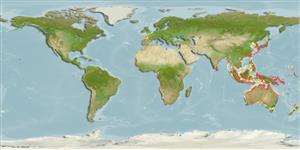Common names from other countries
Classification / Names / Names
Populärnamn | synonymer | Catalog of Fishes (gen., sp.) | ITIS | CoL | WoRMS
Environment: milieu / climate zone / depth range / distribution range
Ekologi
; djupintervall 0 - 30 m (Ref. 349). Subtropical
Eastern Atlantic: Mauritania to Angola. Indo-West Pacific: from the Mascarene Islands and India to Queensland.
Length at first maturity / Size / Vikt / Age
Maturity: Lm ? range ? - ? cm Max length : 4.0 cm SHL hane/ej könsbestämd; (Ref. 349); common length : 3.5 cm SHL hane/ej könsbestämd; (Ref. 438)
Intertidal zone, on sand (Ref. 417) and muddy shores (Ref. 125338). Sometimes in dense populations; also found in shallow subtidal waters; mainly sublittoral (Ref. 349).
Life cycle and mating behavior
Könsmognad | Reproduktion | Lek | Ägg | Fecundity | Larver
Members of the order Neotaenioglossa are mostly gonochoric and broadcast spawners. Life cycle: Embryos develop into planktonic trocophore larvae and later into juvenile veligers before becoming fully grown adults.
Fischer, W., G. Bianchi and W.B. Scott (eds.). 1981. (Ref. 438)
IUCN Red List Status (Ref. 130435)
CITES status (Ref. 108899)
Not Evaluated
Not Evaluated
Threat to humans
Harmless
Human uses
Fiskeri: kommersiell
| FishSource |
Verktyg
Ytterligare information
Age/SizeTillväxtLength-weightLength-lengthMorfologiLarverAbundans
Internet-källor
Estimates based on models
Preferred temperature
(Ref.
115969): 23.6 - 29.3, mean 28.5 (based on 2797 cells).
Vulnerability
Low vulnerability (10 of 100).
Price category
Unknown.
